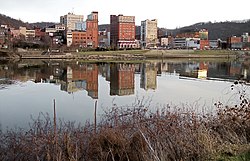History
By the 1900s, Hazel-Atlas was a large glass maker, with 15 plants, including ones in Ada, Oklahoma; Clarksburg, West Virginia; Montgomery, Alabama; Oakland, California; Pomona, California and Zanesville, Ohio. [1] Hazel-Atlas made large quantities of "Depression" pressed glassware in a wide variety of patterns in the 1920s–1940s, along with many white milkglass "inserts" used in zinc fruit-jar lids, many types of milkglass cold-cream jars and salve containers, and a large variety of bottles and jars for the commercial packaging industry. "Atlas" was the brand of the company's most popular line of fruit jars for home canning.
Hazel-Atlas—then the third largest producer of glass containers in the United States, with almost ten percent of the market [2] —became a subsidiary of the Continental Can Company in 1957. The acquisition was challenged under the Clayton Antitrust Act in a case that was eventually decided by the U.S. Supreme Court in United States v. Continental Can Co. . It continued to make containers, glassware, and tableware into the 1960s. In 1964, 10 of the 12 H-A plants in operation were sold to Brockway Glass Company, and it is unclear whether the remaining two plants used the H-A trademark after that year.
This page is based on this
Wikipedia article Text is available under the
CC BY-SA 4.0 license; additional terms may apply.
Images, videos and audio are available under their respective licenses.




